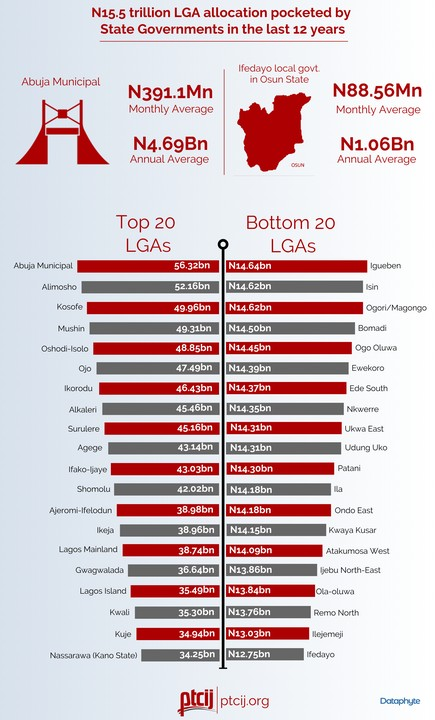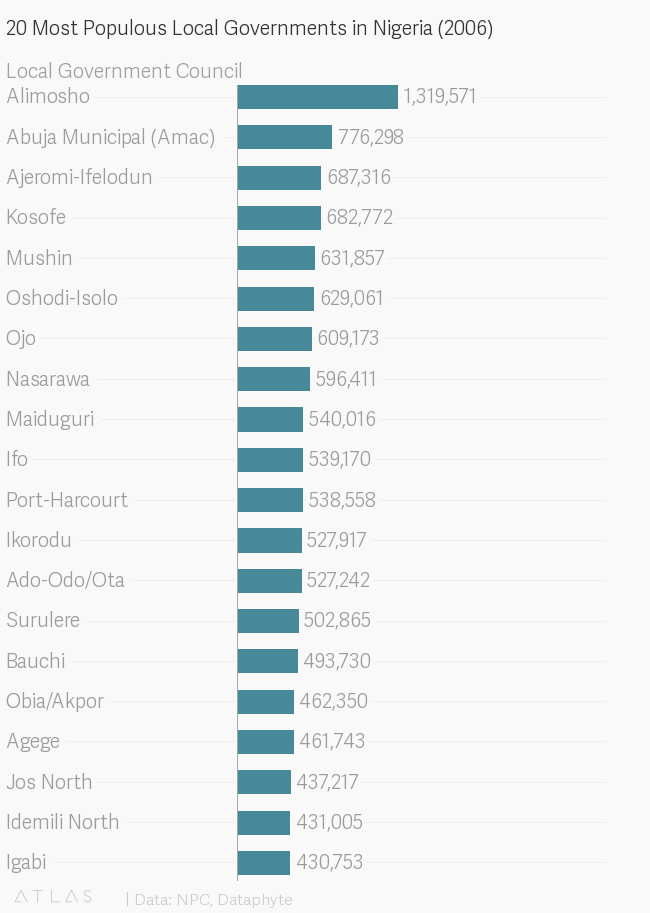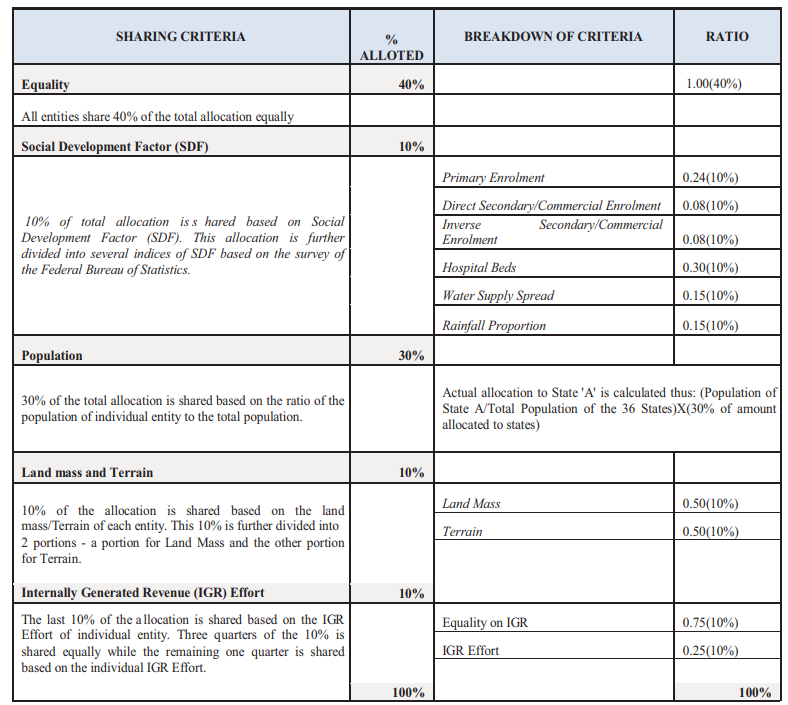

Nigeria’s 36 states and the federal capital territory, Abuja, have pocketed or diverted over N15 trillion federal allocation meant for local governments areas in the last 12 years, depriving the nation’s third tier of government funds for desperately needed developmental projects, data analysed by Dataphyte has shown.
Although that amount was allocated to the 774 local government areas in the country, there is no public information on what portion each local government received.
Local governments are a fundamental part of Nigeria’s political system, and should be closest to the people than the states and federal government. Yet, for years, revenues that should go to them have ended up with their state governments. This has happened because there is no real autonomy for that level of government, and its heads are often hand-picked by state governors.
Data analysis
Based
on analysis of the 12-year data sourced from the websites of the
National Bureau of Statistics and the Office of Accountant-General of
the Federation, about N15.5 trillion (N15,505,489,701,816) has been
transferred to the 36 states and the FCT on behalf of the 774 local
government councils of the country.
Based on available data, an
average of N20 billion accrued to local governments in Nigeria between
2007 and 2012, with the least council having a total of N12.8 billion
and the highest having N56.3 billion.
The monthly LGA transfer is the statutory allocation distributed by the Federation Account Allocation Committee. While Abuja Municipal with the highest allocation has had a monthly average of N391.1 million or an annual average of N4.69 billion, Ifedayo local government in Osun State, with the least allocation, received a monthly average of N88.56 million or an annual average of N1.06 billion.
Lagos, Abuja LGs top earners list
Based on the analysis, the top 20 LGAs in the recipient list were Abuja Municipal – 56.32bn, Alimosho – 52.16bn, Kosofe – 49.96bn, Mushin – 49.31bn, Oshodi-Isolo – 48.85bn, Ojo – 47.49bn, Ikorodu – 46.43bn, Alkaleri – 45.46bn, Surulere – 45.16bn, Agege – 43.14bn, Ifako-Ijaye – 43.03bn, Shomolu – 42.02bn, Ajeromi-Ifelodun – 38.98bn, Ikeja – 38.96bn, Lagos Mainland – 38.74bn, Gwagwalada – 36.64bn, Lagos Island- 35.49bn, Kwali – 35.30bn, Kuje – 34.94bn, and Nassarawa (Kano State) – 34.25bn.
While the bottom 20 on the list in descending order were Igueben – 14.64bn, Isin – 14.62bn, Ogori/Magongo – 14.62bn, Bomadi – 14.50bn, Ogo Oluwa – 14.45bn, Ewekoro – 14.39bn, Ede South – 14.37bn, Nkwerre – 14.35bn, Ukwa East – 14.31bn, Udung Uko – 14.31bn, Patani – 14.30bn, Ila – 14.18bn, Ondo East – 14.18bn, Kwaya Kusar – 14.15bn, Atakumosa West – 14.09bn, Ijebu North-East – 13.86bn, Ola-oluwa – 13.84bn, Remo North – 13.76bn, Ilejemeji – 13.03bn, and Ifedayo – 12.75bn.
As revealed in the chart above, 13 out of the 20 top receiving local governments are from Lagos alone.
A
further drill down shows that not less than 15 of the 25 local
governments that receive the most from the distribution in the last 12
years are from Lagos. The obvious reason for this perhaps is the
population preference given to the allocation of resource revenue. A
prominent principle used in sharing FAAC is the populationof the local
and state governments in the country.
However, only eight
of the 13 local governments from Lagos would qualify on a nominal basis
because they are among the 20 most populated local governments. It is
unclear the rationale that drove the inclusion of the other five.
Some
of the 20 most populated local governments like Nasarawa, Maiduguri,
Ifo, Port-Harcourt, Ado-Odo/Ota, Surulere (Oyo State), Bauchi,
Obia/Akpor, Jos North, Idemili North, Igabi did not make the list for
other reasons only the RMAFC can explain as the commission.
The general notion about federal allocation is that aside from population factor, 13 per cent derivation, a concession given to oil-producing states, determine how much more a state and its local government get compared to counterparts.
An interesting insight from the
analysis, however, reveals none of the local governments from the
oil-producing states made the top 20 receivers list even when the local
governments are among the most populous. For instance, the 2006
population census puts Port-Harcourt (538,558) and Obia/Akpor (462,350)
local government in the 11th and 16th most populated local governments
in Nigeria respectively.
Port-Harcourt, the capital of Rivers
State, only made the bottom of the top 25 while Obia/Akpor was down at
42nd as per top earners. So why did these local governments not make the
top earners list?
Possible reasons
The oil-producing states, especially those in the Niger Delta have continued to describe the nature of federal allocation to their regions as unfair and inequitable given the fact the revenue mainstay, crude oil, comes from their regions.
In a recent report, the governor of Bayelsa, Seriake Dickson, expressed the frustration that his state, as well as other Niger Delta states, are not given the control of their resources among other Federal controls such as oil licencing.
Though the National Bureau of Statistics (NBS) strives to provide data on federal allocation about two months after the disbursement, the data tend to assume every Nigerian understands how the allocation committee came about the values.
NEITI’s Fiscal Allocation and Statutory
Disbursement, FASD, on the other hand tries to show the aggregate
breakdown as seen in the image below. However, it can be assumed that
the values of this criteria change, and citizens and policymakers— at
least at the local government level—do not have supporting documents to
help them understand the recurring breakdown.
The implication is
that the 774 Nigerian local governments are forced to rely on
assumptions from historical data when factoring federal revenue into
their budget planning, as they lack supporting documents that explain
the decision making process federal allocations.
As much as anyone can extrapolate based on the 40 per cent equality share and 30 per cent population quota, the data used to determine other criteria such as school enrollment, amount of rainfall, water supply spread, amount of internally generated revenue, on a rolling basis is not known to the public. Even the population figure is not a clear indicator of federal distribution as its unclear whether FAAC is working with the 2006 Census figure or adjusts this on an annual basis.
Nigeria’s 1999 constitution empowers the Revenue Mobilisation Allocation and Fiscal Commission (RMAFC) to allocate revenue to the three tiers of government.
The challenge posed with assuming the rationale for sharing necessitates a proactive approach from RMFAC to publish the proportion and rationale for allocating FAAC and when it changes, should oblige itself to make the information available to the public.
According to an expert, Adetunji Ogunyemi, lopsidedness in the constitutional division of legislative jurisdiction and the allocation of tax powers, coupled with the failure to develop the best and accepted principles and criteria for the vertical and horizontal distribution of revenues remain the most contentious and intractable challenge in Nigeria’s post-independence.
State Governments and impunity
There has been controversy about the moral standing of state governments to receive and manage LGA allocations from FAAC. The FAAC makes transfers of the statutory allocation of local governments to their respective state governments.
This is in accordance with the 1999 constitution of Nigeria which established the Federal Accounts Allocation Committee (FAAC) and the Joint Allocation and Accounts Committee (JAAC) for the pooling and distribution of Local Government Revenue among state and local governments.
However, federal allocations to local government, for the most part, are just additional revenue for the state governments who then determine how to redistribute in terms of developmental projects across local governments.
It is very clear, to the agitation of civil society, that the state governments are neither transparent nor accountable about the redistribution of FAAC to the municipal executives and legislators with statutory mandates. This is especially worrisome given that state governments always have a hand in local government allocations. Only the governor of Bayelsa has claimed not to touch the local governments’ allocation for his state. The statement is yet to be verified.
Nearly
all the 774 local governments’ executives never got the exact amount
distributed to them and many times accuse their state governments of
misappropriating the funds received on their behalf while also
interfering in the running of the affairs at the grassroots level.
This
is contrary to Nigeria’s legal framework that makes it mandatory for
the state governments to allocate 10 per cent of its
internally-generated revenue to the local councils.
An OECD report decried how state governments have taken over most local government functions in order to justify spending funds earmarked for councils in the Joint Revenue Account, and funds from the Federation Account do not reach the local level.
This is largely because most resources are owned and managed by the federal government, and almost all states and local governments rely on allocations or shares from federal revenues.
Two other positions Mr Ogunyemi noted consistently trouble the realisation of fiscal federalism are illegal custody and disbursement of federally collected revenue and the refusal to act upon audit reports by prosecuting indicted federal officers who deal corruptly with the federations’ treasury.
Section 162 (6), (7) and (

of the 1999 Constitution offer some directions as to the legality of the state government to withhold or deduct from the local government’s share of the allocation.
(6) Each State shall maintain a special account to be called “State Joint Local Government Account” into which shall be paid allocations to the local government councils of the state from the Federation Account and from the government of the state.
(7) Each State shall pay to local government councils in its area of jurisdiction such proportion of its total revenue on such terms and in such manner as may be prescribed by the National Assembly.
(

“The amount standing to the credit of local government councils of a state shall be distributed among the local government councils of that state and in such manner as may be prescribed by the House of Assembly of the State.not for the other.
A
recent report indicated the Nigerian Financial Intelligence Unit, (NFIU)
promised to go after banks who pay local government allocations to
state governments.
Though this sounds like a step in the right
direction, the dilemma lies with the legal rights for NFIU to dictate
how governments exercise their constitutional mandates of resource
distribution.
Way forward
A key development in social accountability arena of Nigeria is the use of public data to demand accountability and unearth corruption in the Nigeria budgetary and procurement process.
Civil society organisations including PTCIJ, PPDC, ICIR, Connected Development, BudgIT, and Value for Money, working with the media have used available data to expose corruption and equip citizens to demand service delivery in their various communities.
It is important therefore for the RMAFC, working with state governments, to provide accessible, accurate and descriptive details of monthly revenue distribution across the states and the 774 local governments of Nigeria.
The auditor -general at the federal and state levels need to beam light into revenue disbursements and spending across the country and ensure the audit report is available to the public and anti-corruption agencies
There is need for deliberate and timely interventions to address issues of local government autonomy in the country.
There
is hardly any local government budget in the public space, which may
allude to the lack of any municipal level of budget planning and
implementation. This hampers grassroots development and constitutes the
usurping of the constitutional role of local governments by state and
federal governments of Nigeria.
Closely related is the need for civil society advocacy and citizen education to drive grassroots demand for transparency and accountability in the disbursements and management of local government allocation. This would involve the publishing of statements of account showing receipts of transfers into local governments’ accounts and monitoring the implementation at the level of councillors and caretaker committees.
Source:- Premiumtimesng



SPONSORED LINKS
[TRENDING SONG!!] Romani D-Fans – Bestie (Prod By Krizbeatz)
[TRENDING MIXTAPE!!] DJ Baddo – Bestie Unlimited Mix
[TRENDING SONG!!] TYSG Ft Bad Mz X Kendi Rozzi – Iyariya
INSTALL 9JAFLAVER MUSIC APP, STREAM, DOWNLOAD, AND PLAY MUSIC OFFLINE
CHECK OUT FUNNY PICTURE AND MEME HERE (CLICK HERE)
Chissom Anthony – Glory To God In The Highest [See Trending Gospel Song]
© 2014-2023 9jaflaver. All Rights Reserved.
About us | DMCA | Privacy Policy | Contact us
| Advertise| Request For Music | Terms Of Service
9jaflaver is not responsible for the content of external sites.